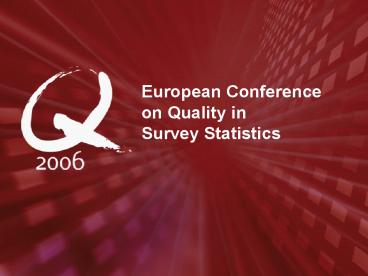European Conference on Quality in Survey Statistics - PowerPoint PPT Presentation
1 / 19
Title:
European Conference on Quality in Survey Statistics
Description:
Indicators are observed (measured in different units) We want an overall score' in order to compare countries... Ordinal sub-indicator share restrictions ... – PowerPoint PPT presentation
Number of Views:140
Avg rating:3.0/5.0
Title: European Conference on Quality in Survey Statistics
1
European Conference on Quality in Survey
Statistics
2
Composite indicators Data Envelopment Analysis
- Q2006Cardiff, April 25 Nicky Rogge(Catholic
University of Leuven)
3
Structure
- Composite indicators useful but subject to
controversy - Normalization and weighting issue
- Background why DEA?
- Incorporating (expert) opinion(sub-indicator
share restrictions)
4
Examples
- Human Development Index (HDI)
- Technology Achievement Index (TAI)
- Environmental Sustainability Index (ESI)
- Misery Index (MI)
5
Composite Indicators
- Indicators are observed (measured in different
units) - We want an overall score in order to compare
countries - but weights for aggregation are not known with
certainty
- Useful tool for policy evaluation and
communication - Useful for comparing and ranking
However, still subject to controversy
6
The normalization issue
Common practice normalizing the sub-indicators
before aggregating.
- No consensus on suitable normalization method
- Results depend on normalization method
2 problems
A meaningful index is defined as an index whose
underlying preference ordering is independent of
admissible transformations of the variables
Ebert and Welsch (2004)
In practice, however, most indices and the
resulting ranks depend on the normalization
method
Potential point of criticism
Removing the necessity to normalize the original
data
7
The weighting issue
Ideally, individual indicators should be weighted
and combined in a manner reflecting the
underlying structure of the evaluated phenomenon.
However, insufficient knowledge on the underlying
structure
Often
Equal Weighting (EW)
Which weights to use? 2 issues
- Any predetermined common set of weights will
favor some countries while harming others. - The choice of weights may affect the composite
indicators and their ranks, undermining their
credibility.
Determine endogenously the optimal set of weights
8
Disagreement among experts proposed weights for
Technology Achievement Index
9
Classical DEA-problem
- Inputs and Outputs are observed (measured in
different units) - We want an overall expression of productivity in
order to compare firms - Productivity (weighted sum of outputs) /
(weighted sum of inputs) - but weights for aggregation are not known with
certainty - (production function, right prices, unknown)
Remarkable similarity between the problem of
measuringefficiency and the one of constructing
composite Indicators
10
Towards DEA composite indicatorStep 1
- Weighted sum of indicators country total
- Since the eventual purpose of a composite
indicator is to compare (with other countries),
we will express this country total RELATIVE TO
A SIMILARLY WEIGHTED SUM of BENCHMARK
SUB-INDICATORS
11
Towards DEA composite indicatorStep 2
- Which benchmark should we choose?
- Look WITHIN SAMPLE of COUNTRIES for the one that
yields the HIGHEST POSSIBLE TOTAL (given the
weights) - Best Practice notion
12
The DEA composite indicatorStep 3
Benefit-of-the-doubt weighting
- Which weights should we choose?
- CHOOSE the weights such that the evaluated
country has a MAXIMAL COMPOSITE INDICATOR VALUE - Benefit-of-the-doubt-notion
13
Benefit-of-the-doubt-notion
- Weights? CHOOSE them (?0) such that the evaluated
country has a maximal composite indicator value - Benchmark ? Look within sample for country that
maximizes CI, given these weights w c,i
14
Advantages
- Qua model better description of reality than
(e.g.) equal weighting - Embedded concern for (MS) diversity no other
weighting scheme yields higher composite
indicator value (political acceptance) - Principle is easy to communicate
- Since we are not sure about the right weights, we
look for benefit of the doubt weights (such
that your overall relative performance index is
as high as possible)
15
- We graphically represent sub indicators as pie
shares with a bigger size reflecting a higher
importance.
Finland 100.00
Poland 30.03
16
sub-indicator share restrictions
- Absolute sub-indicator share restrictions
- Relative sub-indicator share restrictions
- Proportional sub-indicator share restrictions
17
- For the TAI, for example, the lower and upper
bound could be specified by respectively the
lowest and highest weight assigned over all
experts to that sub-indicator.
Netherlands 90.15
Norway 73.25
18
- Ordinal sub-indicator share restrictions
- The restriction imposes an importance ranking of
the sub-indicators.
- Restrictions pertaining to category shares
Relative
Proportional
- Focusing on the importance of key dimensions of
the evaluated phenomenon may allow a more swiftly
expert consensus.
19
European Conference on Quality in Survey
Statistics































